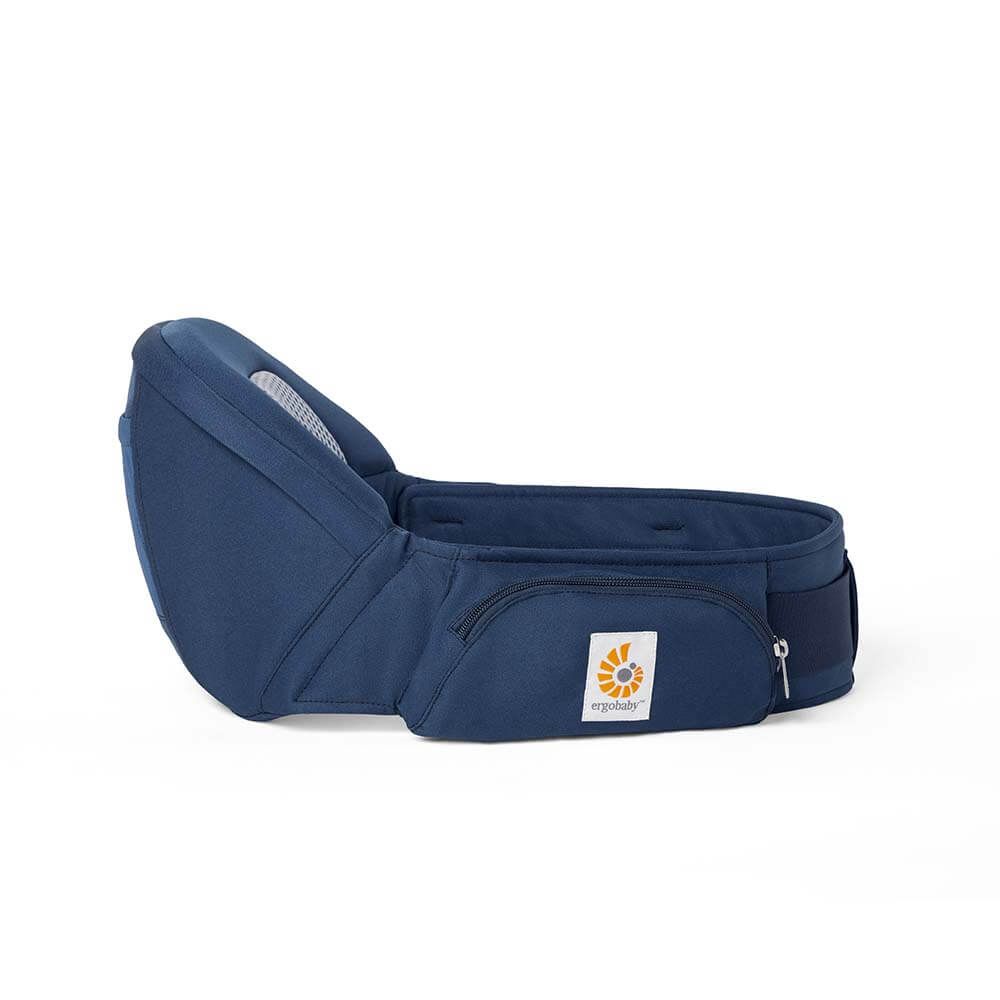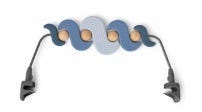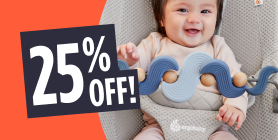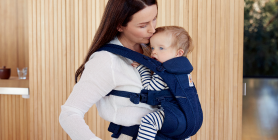Baby Gear
Babywearing
July 28, 2012
When we found out that my cousin would be getting married in Seattle in May 2012, we decided to take a few extra days off and make it into a fun family vacation. High in priority on our packing list for any trip is our Ergobaby Carrier. Back when we had a two year old and a new baby, we bought a second Ergo. Now that our children are older (5 ½ years, 3 ½ years, and 5 months old), we are only using the Ergo with our newest baby. Don’t get me wrong, having two Ergobaby Carriers still comes in quite handy! We are able to keep one in the car and one in the house at all times. But, traveling is an exception! There are too many variables when traveling with young children. You never know what will happen, so always take both of the Ergobaby Carriers!
As has been our experience, the Ergobaby Carrier made traveling by plane much simpler. No surprise there! Once we arrived in Seattle, we decided to buy a City Pass in order to see all of the best attractions at
Baby Gear
Babywearing
July 24, 2012
When our first baby was born we were given a hand-me-down Ergo and we nestled our precious newborn in it with the infant insert – and so began our love affair with babywearing.
Ever since then, there has always been an Ergo in our home. Our first baby is now an active two year old and Ergo has carried him (literally) through every stage – it could be easily be the only carrier you ever need. Of course if you are like us, you might want to try all kinds of different carriers – and even several types of Ergo carriers. There are several carriers we love, but Ergo has always been in heavy rotation in our home. Here are the top reasons we always keep our Ergo within arm’s reach:
Newborn Insert: We loved that we could use it as soon as we brought our baby home with the insert. It came in really handy when our snuggly and sleepy newborn wanted to always be close – but we needed our hands free for basic tasks.
Sleepy Magic: During those tricky times
Baby Gear
Babywearing
July 22, 2012
From: Jodi Kendall Blog "This carrier's comfort stood out during the testing process, and both my husband and I can vouch that we didn't ache or have sore spots after using it. One thing to note about the Aussie Khaki color: it's a new color option for the company, and I especially loved that it channeled a bit of the explorer in me with its look, and my husband felt like it had enough masculine edge for him to feel comfortable wearing too. This carrier color is a great option for couples who crave functional features and something neutral and attractive in appearance. If I was taking my son Townes on one of my expeditions, this is the carrier I would reach for!" Head over to Jodi's blog for the entire review and an exclusive discount code!Emotional Benefits of Getting Outside
Spending time in nature with your baby can strengthen the bond between you. The simple act of holding your baby close, feeling their warmth, and sharing new experiences together can create strong
Baby Gear
Babywearing
May 17, 2012
Back wearing, also known as Back Carrying, seems to elicit both interest and a little bit of fear from babywearing parents. While Back Carrying is one of the most liberating types of carries--it enables you to be hands-free and keep the baby safe from whatever you are doing--it seems to be one of the most daunting carries for parents. Carrying your baby on your back allows the parent to perform many tasks that would otherwise be difficult with a baby on the front. Of course, as with any carry, there are safety precautions, but when followed, the Back Carry can become an indispensable tool in the babywearer’s toolkit--grocery shopping, laundry, meal prep (put baby down when working with anything hot!), dishes, trips to the farmer’s market, for example--all become so much easier with the Back Carry! This is also an ideal carry for the baby to play or really observe the world around her. Historically, Back Carrying has been an essential part of life in many parts of
Baby Gear
Babywearing
February 01, 2012
Kangaroo Care describes a technique in which infants, often premature and underweight, are placed, skin-to-skin, on the chest of the mother or primary caregiver. This position ensures physiological and physical closeness and warmth. The stable body temperature of the parent can effectively regulate the infant’s temperature, and provides easy accessibility to breastfeeding. Even with the advanced technology in NICUs available in the United States, one recent study noted that 82% of neonatal intensive care units in the US include kangaroo care. Originally devised in in 1978, the concept of Kangaroo Care was the brainchild of Dr. Edgar Rey Sanabria, Professor of Neonatology at Universidad Nacional de Colombia, as a response to increasing mortality rates of premature and low birth weight infants. Lacking the resources for technologically advanced equipment and extra nurses and doctors, Sanabria proposed that allowing mothers to remain skin-to-skin with these fragile infants might increase their
Baby Gear
Babywearing
January 04, 2012
“As long as I wear him, he’s content,” Martha Sears, R.N., mentioned to her husband, Dr. William Sears, as they discovered babywearing with their sixth child. It is an affirmation of how life works well naturally. The healthiest choice feels good, and feels right, because it supports survival as well as thriving. Babies reflect this in how they are often calmly alert, or quieted, and relaxed into sleeping easily by the simple practice of babywearing. It is the place a baby wants to be; heart-to-heart, skin-to-skin, breath-to-breath and face-to-face; sharing in life’s activities from a soothing place of familiar rhythm, near a comforting heartbeat and easily accessed breast milk. A baby likes the closeness, the movement, and the loving touches from hands that are free, free…free. Babywearing is a win/win/win choice.
Dr. Sears shares his observations after years of advocating babywearing with his patients: Babies who are worn thrive, are calmer, smarter, make daycare easier, and allow
Baby Gear
Babywearing
January 04, 2012
There is no way to dispute the advantages of carrying a baby as often as possible. Babywearing is the best way to keep both mother and baby happy, while allowing for the tasks that women (and men) need to do while still caring for an infant. Along with making life’s tasks easier, babywearing has been proven to be good for baby, and mother, on a physiological, mental and physical level. The senses are constantly being ignited in this position. Babies can smell more clearly, see, feel, hear and even taste, if they are breastfed, while still in a carrier. Keeping their senses alive and aware is a very good thing for a newborn baby. Mothers, who carry their babies closely, release more oxytocin when carrying their infants. This helps them to bond better with their babies and breastfeed with greater ease. It also lowers the chances of post-partum depression. Babywearing helps the baby to bond with the mother; making her/him feel safe, secure and protected. Babies who are carried
Baby Gear
Babywearing
January 04, 2012
Since the 1950s, more doctors have acknowledged the tremendous healing power of bonding with our young through babywearing, physical contact, breastfeeding and family beds. The physical, mental and emotional health benefits are unsurpassed by any drug or remedy known to man with the benefits lasting a lifetime. Hopefully, this article helps parents to bond with their offspring through a means that is biologically compatible with their infants’ needs because our babies are movement-starved. Bonding is the physical, mental, emotional, and, some might add, spiritual, connection and attachment most parents make with their offspring to varying degrees. It deeply engages all the senses. “The mother is endocrinologically, sensually, as well as neurologically transformed in ways likely to serve the infant’s needs and contribute to her own posterity. The hormone oxytocin, also called the love drug, and known to be as addictive as morphine, is released while breastfeeding, snuggling, or massaging.
Baby Gear
Babywearing
December 01, 2011
There is little that is more upsetting to parents of a newborn than his inconsolable wails and cries. To parents of a baby with colic, these bouts are all too common, and can cause turmoil and disharmony in even the most solid, happy families.
As the mother of three, I am well aware of the challenges of being a parent to a new being. Each baby is distinctly unique and different from his siblings. My first child had a lovely disposition – cheerful, happy, and content. I thought I had parenting completely figured out, and I wondered about parents who seemed frazzled or stressed by their newborn. What was so difficult about having an infant?
Enter child number two: born two weeks before his predicted due date, he was small and incredibly sensitive. His skin reacted to any fabric, with angry bumps. He rarely slept, except in increments of about ten minutes, from which he awoke shrieking. At around six p.m. each night, he descended into a furious fit of wailing that lasted for about an hour,
Baby Gear
Babywearing
December 01, 2011
Sometimes, whatever you do it is not going to work, and sometimes, doing nothing is what works best. This is true of a lot of things in life, from curing a headache to fixing a drain, but is never more obvious than when trying to stop a baby from crying. This morning, I was taking my usual walk. It’s a 2.2-mile loop that takes me about 40 minutes. It is a great part of my day, and I always see an interesting cross section of people in the neighborhood walking, running, biking and pushing baby strollers. Today, while I was about half-way around, I saw a young couple walking towards me with their baby screaming at the top of her lungs in her stroller. They looked so tired, so utterly exhausted, that I had to say something to them. “Rough night?” I asked. After rolling their eyes and nodding their heads in agreement, they said, “You know it!” We chatted for a moment, and I commiserated with them about their struggle. “Sometimes just taking her outside is the only thing that helps.”
























